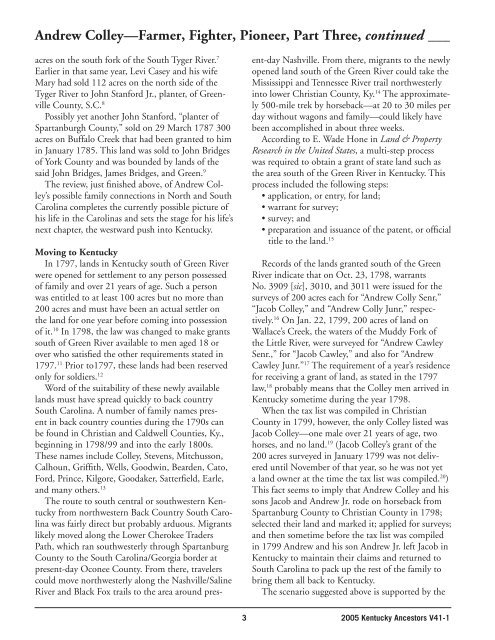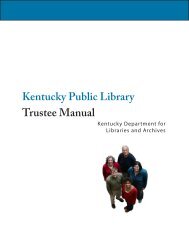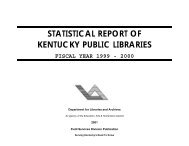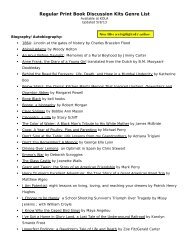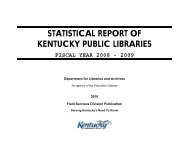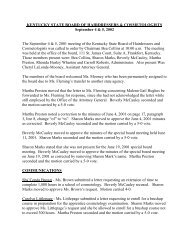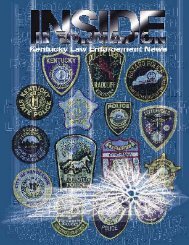kentucky ancestors - e-archives Home
kentucky ancestors - e-archives Home
kentucky ancestors - e-archives Home
Create successful ePaper yourself
Turn your PDF publications into a flip-book with our unique Google optimized e-Paper software.
Andrew Colley—Farmer, Fighter, Pioneer, Part Three, continued ___<br />
acres on the south fork of the South Tyger River. 7<br />
Earlier in that same year, Levi Casey and his wife<br />
Mary had sold 112 acres on the north side of the<br />
Tyger River to John Stanford Jr., planter, of Greenville<br />
County, S.C. 8<br />
Possibly yet another John Stanford, “planter of<br />
Spartanburgh County,” sold on 29 March 1787 300<br />
acres on Buffalo Creek that had been granted to him<br />
in January 1785. This land was sold to John Bridges<br />
of York County and was bounded by lands of the<br />
said John Bridges, James Bridges, and Green. 9<br />
The review, just finished above, of Andrew Colley’s<br />
possible family connections in North and South<br />
Carolina completes the currently possible picture of<br />
his life in the Carolinas and sets the stage for his life’s<br />
next chapter, the westward push into Kentucky.<br />
Moving to Kentucky<br />
In 1797, lands in Kentucky south of Green River<br />
were opened for settlement to any person possessed<br />
of family and over 21 years of age. Such a person<br />
was entitled to at least 100 acres but no more than<br />
200 acres and must have been an actual settler on<br />
the land for one year before coming into possession<br />
of it. 10 In 1798, the law was changed to make grants<br />
south of Green River available to men aged 18 or<br />
over who satisfied the other requirements stated in<br />
1797. 11 Prior to1797, these lands had been reserved<br />
only for soldiers. 12<br />
Word of the suitability of these newly available<br />
lands must have spread quickly to back country<br />
South Carolina. A number of family names present<br />
in back country counties during the 1790s can<br />
be found in Christian and Caldwell Counties, Ky.,<br />
beginning in 1798/99 and into the early 1800s.<br />
These names include Colley, Stevens, Mitchusson,<br />
Calhoun, Griffith, Wells, Goodwin, Bearden, Cato,<br />
Ford, Prince, Kilgore, Goodaker, Satterfield, Earle,<br />
and many others. 13<br />
The route to south central or southwestern Kentucky<br />
from northwestern Back Country South Carolina<br />
was fairly direct but probably arduous. Migrants<br />
likely moved along the Lower Cherokee Traders<br />
Path, which ran southwesterly through Spartanburg<br />
County to the South Carolina/Georgia border at<br />
present-day Oconee County. From there, travelers<br />
could move northwesterly along the Nashville/Saline<br />
River and Black Fox trails to the area around pres-<br />
ent-day Nashville. From there, migrants to the newly<br />
opened land south of the Green River could take the<br />
Mississippi and Tennessee River trail northwesterly<br />
into lower Christian County, Ky. 14 The approximately<br />
500-mile trek by horseback—at 20 to 30 miles per<br />
day without wagons and family—could likely have<br />
been accomplished in about three weeks.<br />
According to E. Wade Hone in Land & Property<br />
Research in the United States, a multi-step process<br />
was required to obtain a grant of state land such as<br />
the area south of the Green River in Kentucky. This<br />
process included the following steps:<br />
• application, or entry, for land;<br />
• warrant for survey;<br />
• survey; and<br />
• preparation and issuance of the patent, or official<br />
title to the land. 15<br />
Records of the lands granted south of the Green<br />
River indicate that on Oct. 23, 1798, warrants<br />
No. 3909 [sic], 3010, and 3011 were issued for the<br />
surveys of 200 acres each for “Andrew Colly Senr,”<br />
“Jacob Colley,” and “Andrew Colly Junr,” respectively.<br />
16 On Jan. 22, 1799, 200 acres of land on<br />
Wallace’s Creek, the waters of the Muddy Fork of<br />
the Little River, were surveyed for “Andrew Cawley<br />
Senr.,” for “Jacob Cawley,” and also for “Andrew<br />
Cawley Junr.” 17 The requirement of a year’s residence<br />
for receiving a grant of land, as stated in the 1797<br />
law, 18 probably means that the Colley men arrived in<br />
Kentucky sometime during the year 1798.<br />
When the tax list was compiled in Christian<br />
County in 1799, however, the only Colley listed was<br />
Jacob Colley—one male over 21 years of age, two<br />
horses, and no land. 19 (Jacob Colley’s grant of the<br />
200 acres surveyed in January 1799 was not delivered<br />
until November of that year, so he was not yet<br />
a land owner at the time the tax list was compiled. 20 )<br />
This fact seems to imply that Andrew Colley and his<br />
sons Jacob and Andrew Jr. rode on horseback from<br />
Spartanburg County to Christian County in 1798;<br />
selected their land and marked it; applied for surveys;<br />
and then sometime before the tax list was compiled<br />
in 1799 Andrew and his son Andrew Jr. left Jacob in<br />
Kentucky to maintain their claims and returned to<br />
South Carolina to pack up the rest of the family to<br />
bring them all back to Kentucky.<br />
The scenario suggested above is supported by the<br />
2005 Kentucky Ancestors V41-1


